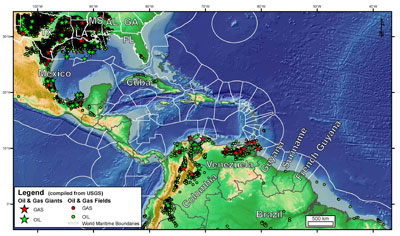Caribbean Basins, Tectonics and Hydrocarbons Project Moves to UH
 Paul Mann joined the faculty of the Department of Earth and Atmospheric Sciences in June as a professor of geology. His move also signals the relocation to University of Houston of the Caribbean Basins, Tectonics and Hydrocarbons (CBTH) Project.
Paul Mann joined the faculty of the Department of Earth and Atmospheric Sciences in June as a professor of geology. His move also signals the relocation to University of Houston of the Caribbean Basins, Tectonics and Hydrocarbons (CBTH) Project.
The CBTH Project is directed by Mann and includes a 15-member energy industry consortium of project sponsors. A large part of Mann’s CBTH research team relocated from the University of Texas at Austin (UT) in July.
“Dr. Mann’s arrival represents a significant step for UH’s new energy initiative,” said John Casey, professor and chair of the earth and atmospheric sciences department.
The CBTH project is an oil industry consortium that began under Mann's leadership at UT in 2005. The goal of the project was to involve undergraduate, graduate and postdoctoral researchers in a major, GIS-based compilation of hydrocarbon-related information from a vast, hydrocarbon-rich region extending from the Gulf of Mexico to Brazil. Over the past six years, this data set has become the most complete source of information on hydrocarbon basins in this region.
In addition to providing this information to the oil company sponsors of the project, subsurface seismic reflection and well data compiled by CBTH researchers also provided the basis for original research used for completing M.S. theses and Ph.D. dissertations.
“While the program was at UT, funds from the CBTH project supported up to 21 persons in a single year and produced a total of three, two-year postdoctoral studies, two Ph.D. dissertations, 14 master's theses, and employed 12 UT undergraduates as research assistants,” Mann said.
The CBTH research effort also includes the research group of Alejandro Escalona, a Ph.D. graduate of the CBTH project at UT and now an associate professor at the University of Stavanger in Norway. In the period of 2005-2011, the combined UT-Stavanger group produced a total of 31 publications in peer-reviewed journals, including one special issue each in the Bulletin of American Association of Petroleum Geologists (AAPG) and Marine and Petroleum Geology. Many of these publications have been first-authored by the M.S. and Ph.D. students who were supported by the project. At the April 2011 AAPG Annual Convention and Exhibition in Houston, one M.S. and one Ph.D. student working with the CBTH project at UT won the first and third place best student poster awards.
At UH, the CBTH project will continue to operate in the same way as it has for the past six years at UT.
“The project will continue to expand its GIS database and make these data available to the oil company sponsors of the project to facilitate their hydrocarbon exploration efforts in the region,” Mann said. “These data will also form the basis for in-progress and future M.S., Ph.D. and postdoctoral research projects.”
CBTH will also continue to work closely with sponsoring oil companies, many of which are headquartered in the greater-Houston area. These sponsors provide the financial support and most of the data used in the project and hire many of the CBTH graduates as summer interns and full-time exploration geologists and geophysicists.
The project is planning to establish an exchange program at the undergraduate and graduate level in petroleum geology and geophysics between the University of Stavanger in Norway and the UH Department of Earth and Atmospheric Sciences. Students could complete coursework not available in their home institutions and work on their research projects. Because all geosciences teaching in Stavanger is done in English, UH students will be able to quickly adjust to classes in Norway.
A 2,000 square foot, state-of-the-art research lab is currently under construction on the fourth floor of the Science and Research 1 Building on the UH campus. This facility will house GIS and seismic support personnel, visiting scientists, computer workstations, 3D visualization equipment, servers, scanners, and other equipment needed for the study.
For more information, please visit the UH Caribbean Basins, Tectonics and Hydrocarbons Project website.
- Paul Mann and Kathy Major, College of Natural Sciences and Mathematics